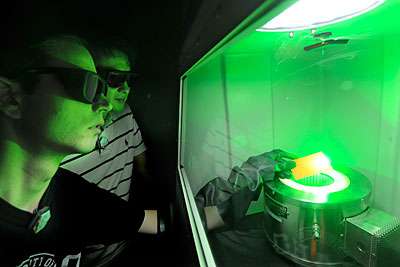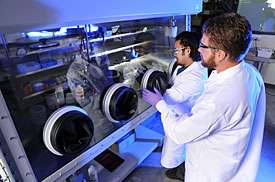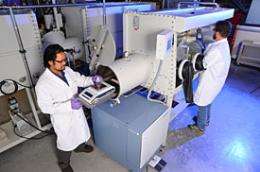Laser-Induced Breakdown Spectroscopy uses a high-power laser within the Center for Advanced Energy Studies at INL. The technique can discern the contents of used nuclear fuel and potentially boost the global security of nuclear recycling. Credit: Post Register
James Bond uses a laser beam to cut through windows and walls, but scientists at the Center for Advanced Energy Studies (CAES) are using a new laser that can melt metal.
The laser resides in the CAES Radiochemistry Lab. Within a special room inside an impeccably clean and ultra-secure laboratory, scientists are evaluating a system called Laser-Induced Breakdown Spectroscopy (LIBS), which uses a high-power laser to discern the contents of used nuclear fuel.
Some countries have chosen reprocessing as a way to reduce high-level waste and get more energy from used nuclear fuel rods. However, fuel reprocessing must include safeguards that account for the quantities of nuclear material, as well as maintain process control and safety. The ability to identify elements such as plutonium and uranium that are present in the used nuclear fuel is an important part of this process.
For example, from a security standpoint, a system that can detect the absence of a particular element or isotope can help deter nuclear material theft. This type of rapid-detection system could benefit public safety and global security.
Today, the process to analyze isotopes is time-intensive—typically taking days to transport, process and analyze a sample. For international safeguards, this process takes even longer, since the samples must be sent to a different facility, often in another country. At the CAES Radiochemistry Laboratory, researchers are working to prove a method that would reduce that time to a matter of minutes.
"This is vital in improving material accountability in nuclear reprocessing," said Supathorn Phongikaroon, a University of Idaho/CAES researcher and the project's principal investigator. CAES is a partnership between Idaho National Laboratory, Boise State University, Idaho State University and University of Idaho. "We have to find the optimal way of controlling and managing waste in the U.S., and LIBS is one possible option that we are exploring."
Recycling in a nutshell
There are two main types of nuclear reprocessing technologies: aqueous separation, and electrochemical (or nonaqueous pyroprocessing) separation. Aqueous separation, the most common method of used fuel recycling, involves dissolving fuel elements in selective acids (like nitric acid) before chemically separating uranium and plutonium from the mix. In electrochemical separation, nuclear fuel is put into molten salt. Then, an electrical current is applied to dissolve and purify the uranium. Several facilities have explored and investigated electrochemical processing to treat used nuclear fuel for decades. The approach offers many advantages, such as a simplified and more compact process.
"Extensive work with molten salt hasn't been done very much because the need for a high-temperature operation makes it a very unique capability," said Phongikaroon. "Our lab is distinctive because it is one of few facilities designed to work with this technology."
The LIBS laser research is taking place within the Radiochemistry Lab at the Center for Advanced Energy Studies.
Phongikaroon explained that his lab focuses on pyroprocessing technology, a method where materials are subjected to extremely high temperatures (usually up to 800°C) in order to complete a chemical or physical change. The lab uses the laser as a novel tool to detect elements in the molten salt during the chemical reaction.
LIBS fully engaged
A recent demonstration began inside an atmospheric glovebox with a highly controlled atmosphere. Ammon Williams, Phongikaroon's graduate research assistant, pointed out the laser port: a very small quartz window on the ceiling of the glovebox. Underneath the laser port is a donut-shaped furnace where the molten salts sit. When Williams flipped a switch, activating the laser flash lamp, a whirring sound like a distant helicopter came on.
Peering into the glovebox through special, semi-opaque laser safety glasses revealed that nothing had changed inside.
"The laser safety glasses block blue and green wavelengths so they protect your eyes from the laser (which has a green light)," explained Williams. He demonstrated by stepping around the corner from the glovebox window and tipping his head up to peer at the wall from under the rim of the lens. From this position, the laser's light flashed on the wall—an intense green light flickering in peripheral vision. Dropping the glasses back down, the light disappeared—the whirring fan giving the only clue the laser was still on.
The LIBS system uses a Class IV pulsed laser—each pulse lasts for eight nanoseconds and contains 40 to 140 millijoules of energy, or approximately 17,500,000 watts (W) of power. By comparison, a normal laser pointer is usually a Class III continuous wave laser, which typically maxes out around 0.005 W.
"If this were a continuous wave laser, it would burn a hole right through that table," said Williams, before switching the LIBS laser off.
The heat from the laser converts a speck of molten salt into plasma. As it cools, the elements inside the plasma emit photons. Different isotopes from elements give off characteristic photons at different wavelengths (uranium isotopes of interest typically show up around 416 nanometers). The photons and their wavelengths are collected by a spectrograph and an Intensified Charge Couple Device (ICCD) detector connected to the glovebox.
University of Idaho and CAES researcher Supathorn Phongikaroon, left, leads the LIBS research project.
As the device records wavelengths, the different elements (and their isotopes) appear on a graph that is being recorded. By cross-referencing these graphs with known measurements of element wavelengths, analysts can construct a picture of the used fuel and fission by-products in the molten salt. Specifically, the wavelengths and intensity of the light collected can reveal the contents of the fuel, enabling precise calculations of how much plutonium or uranium is in the sample. Such information can help optimize processes and aid nuclear proliferation inspectors.
Securing reprocessing's future
While next-generation nuclear technologies continue to advance, improved safety assessments are important for maintaining public security. During electrochemical processing, a variety of byproducts accumulate in the salt, like fission product chlorides and rare earth metals. These products can cause unwanted problems in operating conditions—having a tool like LIBS could help operators prevent buildup or technology failures.
Additionally, LIBS could provide real-time analysis of used nuclear fuel during recycling, a capability useful for both industry and government agencies. Knowing the element ratios throughout the recycling procedure can also prevent plutonium diversion for illicit use. While sampling locations and procedures themselves can prove challenging, the rapid measurements provided by LIBS could both monitor operations and detect anomalies during the recycling process.
"I think that LIBS has an important future in the nuclear field; it is at the forefront of the emerging technology," said Williams.
Phongikaroon's lab is still working on nonirradiated samples and experimenting with changing combinations of elements to test how accurately LIBS can record ratios. Soon the researchers will use cerium and manganese to calibrate the LIBS system. Since cerium emits characteristic wavelengths in the same range as plutonium, it is a good nonradioactive surrogate for testing how LIBS will run with the real thing.
"Our goal is to enhance safety and account for materials inside electrorefiners and nuclear waste," said Phongikaroon. "Using a process like LIBS, we won't have to wait days to have samples analyzed. This is vital in improving material accountability in nuclear reprocessing."
Provided by Idaho National Laboratory

























